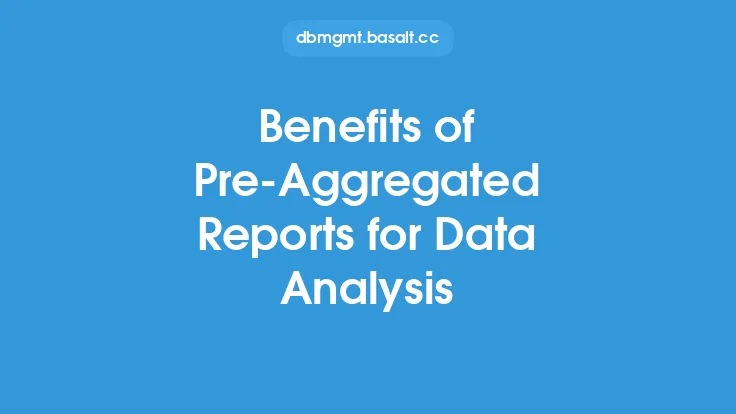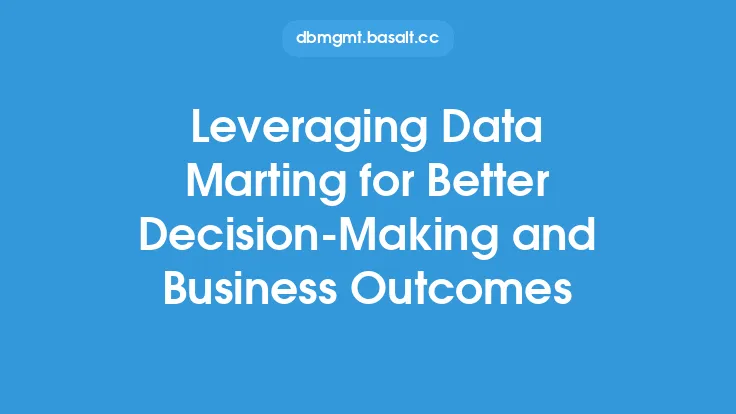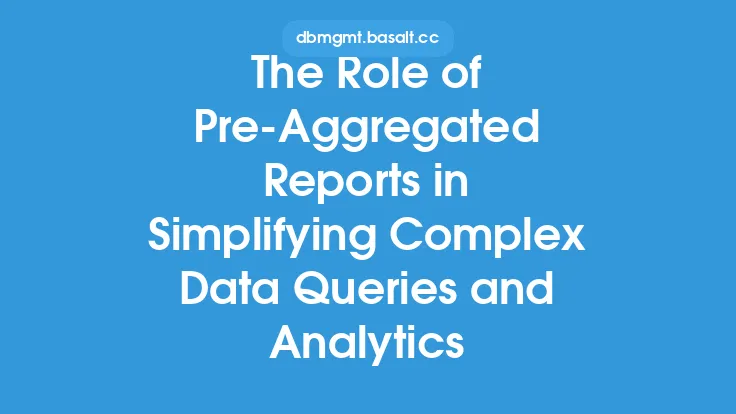In the realm of data analysis and business intelligence, the ability to effectively visualize and interpret complex data is crucial for informed decision-making. One technique that has gained significant attention in recent years is the use of pre-aggregated reports, which involves storing aggregated data in a separate table or data structure to improve query performance and facilitate faster data analysis. By leveraging pre-aggregated reports, organizations can enhance their data visualization capabilities, streamline their decision-making processes, and gain a competitive edge in the market.
Introduction to Pre-Aggregated Reports
Pre-aggregated reports are a type of data denormalization technique that involves pre-computing and storing aggregated data, such as sums, averages, and counts, in a separate table or data structure. This approach allows for faster query execution and improved data analysis, as the aggregated data is already computed and readily available. Pre-aggregated reports can be used in a variety of applications, including business intelligence, data warehousing, and big data analytics.
Data Visualization with Pre-Aggregated Reports
Pre-aggregated reports can be used to enhance data visualization by providing a simplified and aggregated view of complex data. By storing pre-computed aggregates, organizations can quickly generate reports and visualizations that showcase key trends and patterns in their data. For example, a company can use pre-aggregated reports to create a dashboard that displays sales data by region, product category, and time period. This allows business users to quickly identify areas of strength and weakness, and make informed decisions about resource allocation and strategic planning.
Technical Implementation of Pre-Aggregated Reports
From a technical perspective, implementing pre-aggregated reports requires careful consideration of several factors, including data modeling, indexing, and query optimization. One common approach is to use a star or snowflake schema, which involves creating a fact table that contains the aggregated data, surrounded by dimension tables that provide context and filtering capabilities. The fact table can be indexed and optimized for query performance, allowing for fast and efficient retrieval of aggregated data.
Benefits of Pre-Aggregated Reports for Decision-Making
The use of pre-aggregated reports can have a significant impact on an organization's decision-making capabilities. By providing fast and easy access to aggregated data, pre-aggregated reports enable business users to quickly identify trends and patterns, and make informed decisions about strategic planning and resource allocation. Additionally, pre-aggregated reports can help organizations to identify areas of inefficiency and waste, and make data-driven decisions about process improvement and optimization.
Best Practices for Creating Effective Pre-Aggregated Reports
To create effective pre-aggregated reports, organizations should follow several best practices, including defining clear business requirements, selecting the right data aggregation techniques, and optimizing query performance. It is also important to consider data governance and security, ensuring that pre-aggregated reports are properly authorized and access-controlled. By following these best practices, organizations can create pre-aggregated reports that are accurate, reliable, and actionable, and that provide significant value to business users and decision-makers.
Real-World Applications of Pre-Aggregated Reports
Pre-aggregated reports have a wide range of real-world applications, including business intelligence, data warehousing, and big data analytics. For example, a retail company can use pre-aggregated reports to analyze sales data by product category, region, and time period, and make informed decisions about inventory management and supply chain optimization. Similarly, a financial services company can use pre-aggregated reports to analyze customer data and behavior, and make informed decisions about risk management and portfolio optimization.
Future Directions for Pre-Aggregated Reports
As data volumes and complexities continue to grow, the use of pre-aggregated reports is likely to become even more important for organizations seeking to gain insights and make informed decisions. Future directions for pre-aggregated reports include the use of advanced data aggregation techniques, such as machine learning and artificial intelligence, and the integration of pre-aggregated reports with other data analytics and business intelligence tools. Additionally, the use of cloud-based and distributed computing architectures is likely to become more prevalent, allowing organizations to scale their pre-aggregated reporting capabilities and handle large volumes of data.





